Real Betis entered this encounter in scintillating form, claiming 10 points in their previous four league games and a 4-0 win in the Copa Del Rey.
Atlético Madrid was another story. They entered the day with 5 points from the previous four league games while winning and losing a pair of UEFA Champions League games.
For Betis, a win would get them three points closer to one of those highly coveted continental qualification spots, whereas a win would keep Atlético in the title hunt. Despite 67% possession, Real Betis was unable to crack Atlético and fell 2-1 in their La Liga bout.
In this tactical analysis, we’ll look at the contrasting tactics of the two sides. For Atlético Madrid, staunch defence and direct play ruled the day, as they capitalized on Real Betis’ mistakes. Analysis of Betis will show that, while they had some success on set pieces, they simply weren’t able to break Atlético’s lines and create high-quality scoring opportunities.
Lineup
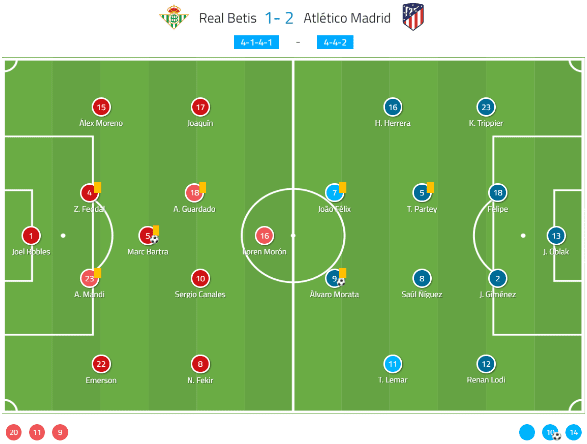
Rubi lined up his Real Betis side in a 1-4-1-4-1. Joel Robles started in goal with the explosive Emerson at right-back, Álex Moreno on the left and the pairing of Aissa Mandi and Zouhair Feddal at centre-back. In the midfield, Marc Bartra played the pivot with Andrés Guardado and Sergio Canales playing ahead of him. Joaquín and Nabil Fekir got the starts out wide, operating more like forwards in a narrow 1-4-3-3, while Loren Morón took his usual place up top.
Diego Simeone countered with his standard 1-4-4-2. Jan Oblak took his place between the pipes. His backline consisted of Kieran Trippier, Renan Lodi, Felipe and José Giménez. In the midfield, Héctor Herrera, Thomas Partey, Saúl Ñíguez and Thomas Lemar started from right to left. Up top, João Félix paired with Álvaro Morata.
Atlético’s defensive structure
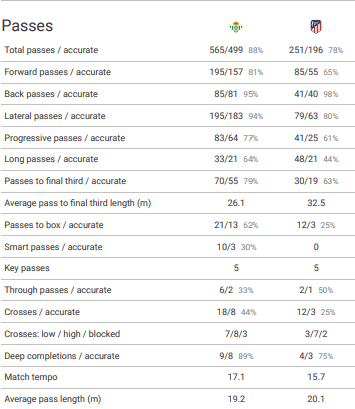
Atlético’s midfield line of confrontation didn’t directly produce any shots, but it was extremely difficult to beat. Joaquín and Morón didn’t have a single touch in the box, Fekir was the only starter among the forwards and attacking midfielders to get more than one touch in the box. He recorded four, which finished second on the team behind Emerson’s nine. Moreno was third on the team with three and Bartra rounded out the multiple touches group with two.
Betis had an impressive passing accuracy total for the game, registering an 88% success rate. In fact, Betis had superior statistics to Atlético in nearly every form of pass, but their passing didn’t lead to greater goal scoring opportunities. The incredibly efficient numbers give an indication of how safe most of the passes were.
One of the reasons Atlético claimed all three points is it made a concerted effort to control the central channel and half-spaces. When Betis tried to penetrate through the middle, Atlético’s midfield warriors were there to put in a tackle. As Betis attacked, Atlético funnelled play into the wings. Betis complied, often looking for a group of three attackers against three Atlético defenders. While Betis did manage to beat Atlético on the wings a few times and get into the box, Atlético managed to contain the attacks and limit Betis to low-quality opportunities.
Betis went 46 minutes between their third and fourth shots. On the game, Betis’ best shots came from set pieces (more on this in a moment) and attempted from outside the box. By forcing Betis to progress through the wings, Atlético had plenty of time to recover when beat and always had numerical superiority deep in their end.
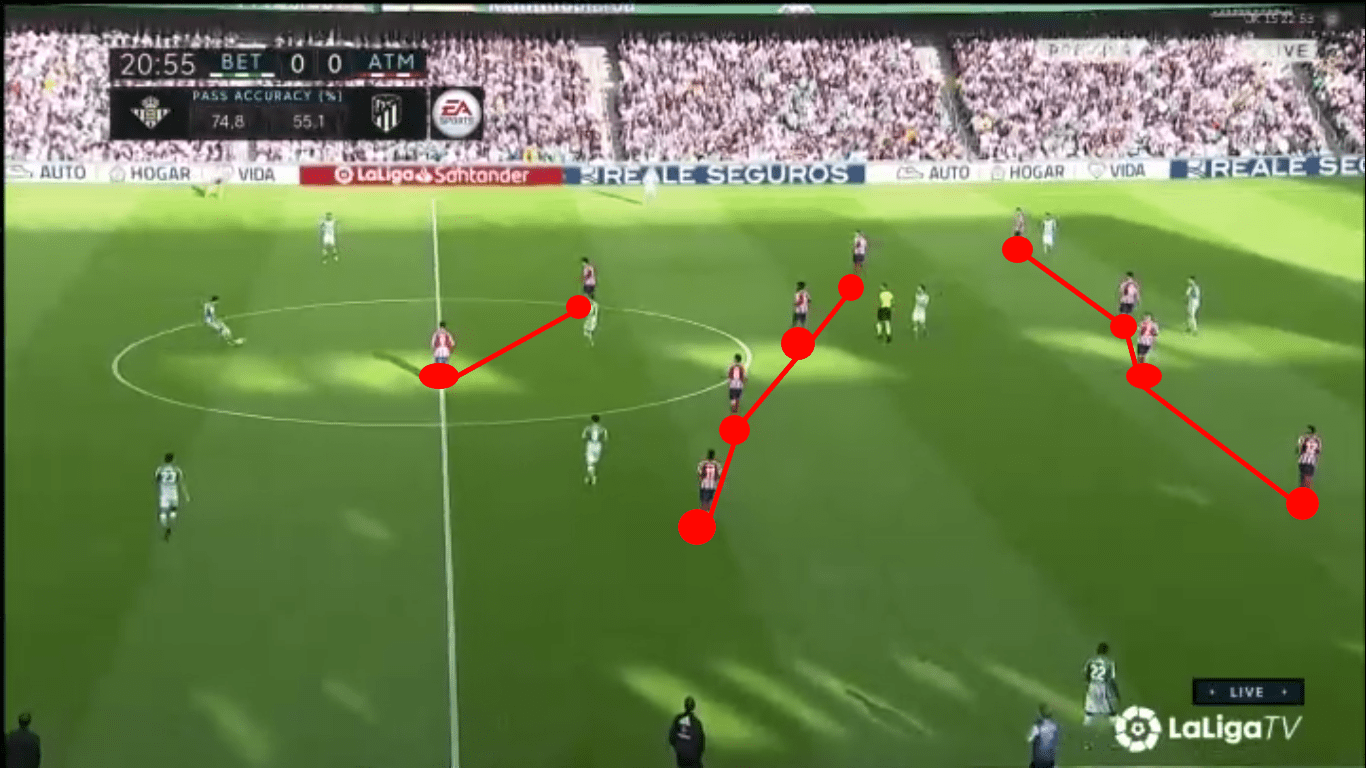
This sequence starts a long possession for Betis, giving a great idea of how Atlético defended in different situations. First, Bartra dropped in between the two centre-backs, a common theme in this game, allowing Emerson and Moreno to push higher up the field. You can see Betis overloading their left-side, leaving the dynamic Brazilian, Emerson, isolated on the right. Ideally, he would receive the ball and cross for the three forwards. Atlético was willing to concede the wings and instead took away the middle while keeping two players in each of the half-spaces. As the ball moved into the wings, a coordinated team movement ensured Atlético were defending in three channels.
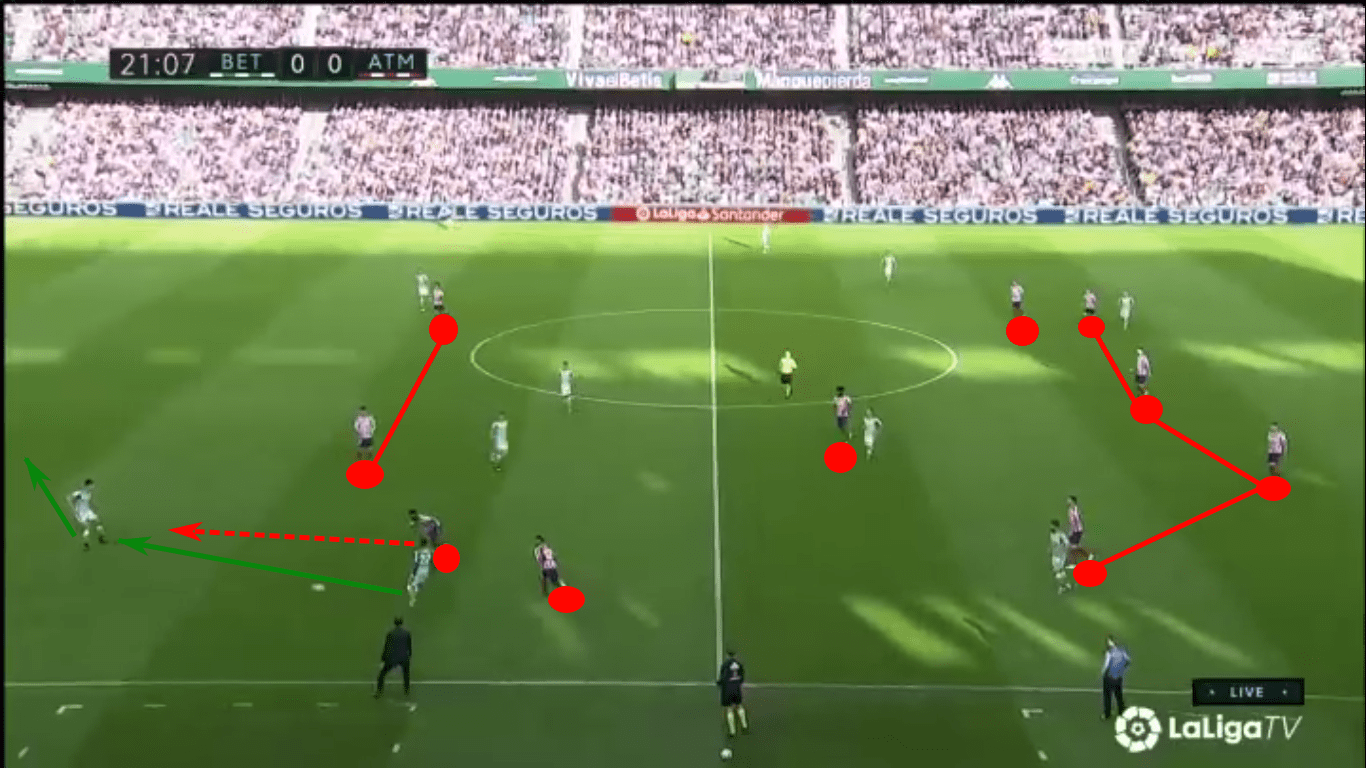
When the ball arrived in the wings, Atlético closed down quickly, forcing Betis to send numbers in support. The two teams often engaged in 3v3 duels in the wings. Atlético contained at first, but the moment they had the outlet passes marked, the three in the wing engaged at 100% intensity. Though Betis was able to beat the pressure a few times, Atlético was generally able to win the ball or force Betis backward, as happened in this image.
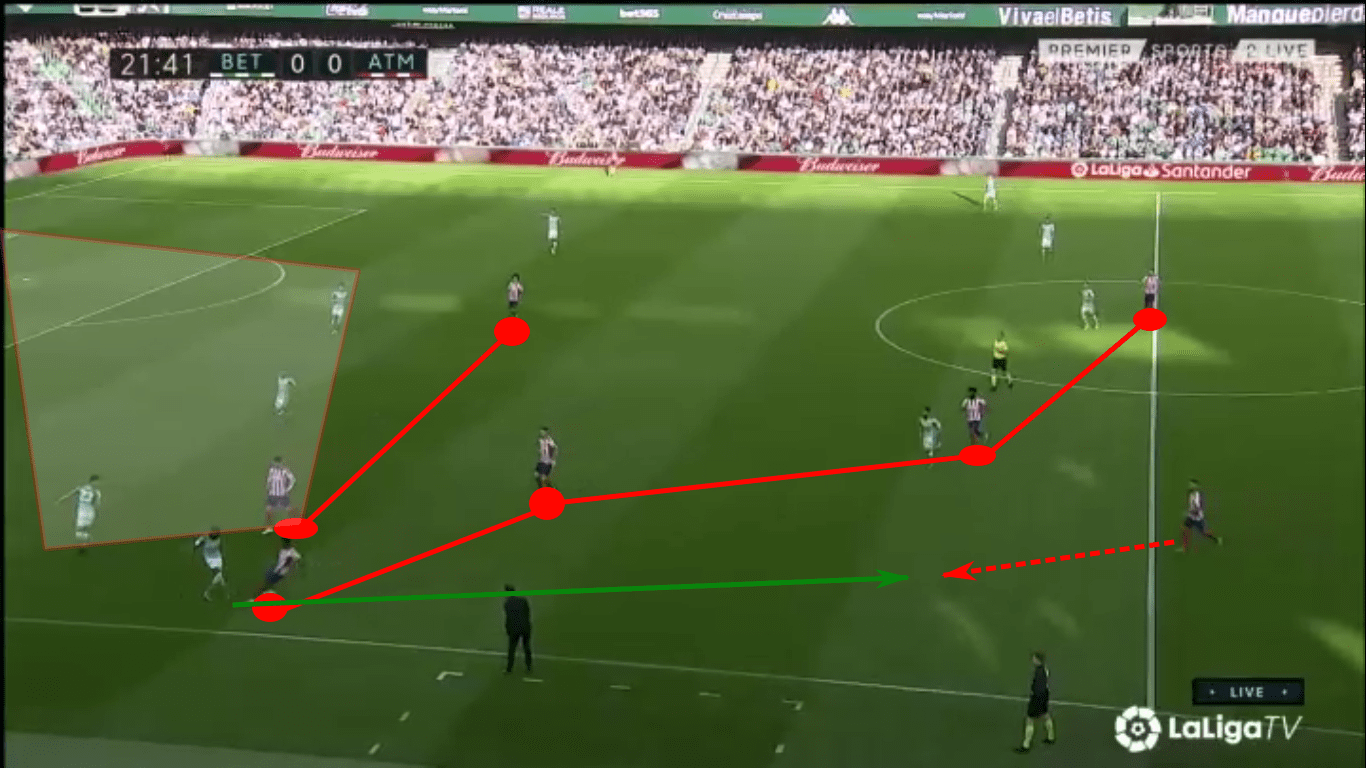
Betis continued the sequence by playing side-to-side along the back. Sensing the opportunity for a counterattack against their vulnerable opponent, Atlético slowly and uniformly advanced with each negative pass, systematically cutting off outlets and funnelling play to the wings. As Betis tried to move the defence, Atlético simply regrouped and waiting for Betis to play wide. When it had Betis trapped against the touchline and outlets cut off, Atlético pressured again, this time forcing a bad pass and winning the ball.
Real Betis’ Set Pieces
While Betis had a few very close strikes from long distance, its best chances of the game came via set pieces. If Betis played directly into the box, Atlético generally had the structure to defend the cross. However, when Betis played indirectly, Atlético suffered from poor pressure on the ball, with Betis often outsmarting them.
One of the reasons Betis had some success on set pieces is because they had some of their best attacking players against Atlético’s more attack-oriented players. Numerical equality and superiority often resulted in Betis creating opportunities from dangerous areas. In two of these scenarios, the final pass came from the half-space in the box. Sending the final ball from that prime location resulted in more accurate deliveries into the box and dangerous shots.
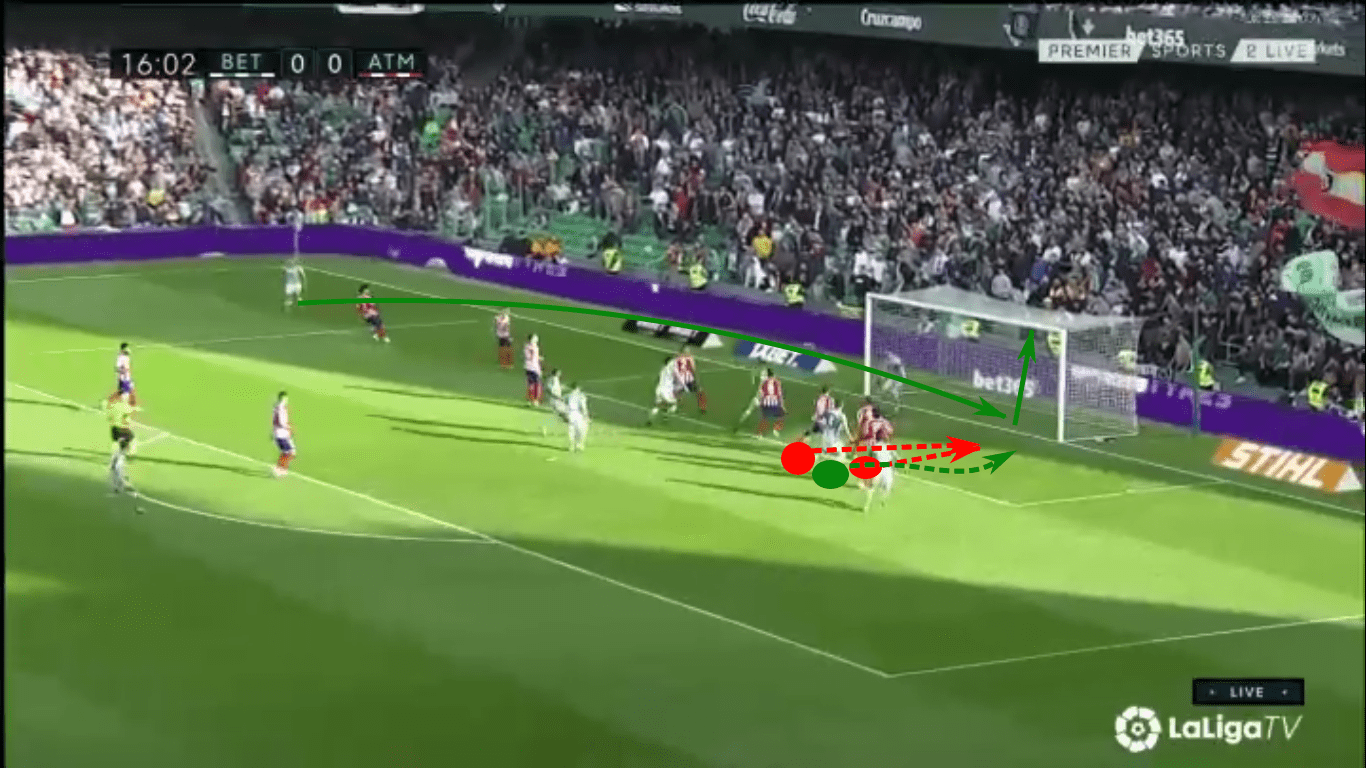
In this set piece, Joaquín played short to Canales, who got around João Félix and send a cross the back post. Initially, Felipe was marking Feddal, but the Betis man slid closer to the back post. Lodi should have picked him up and positioned himself to him the cross, but he gave Feddal the best lane to the ball. Without the clean switch, Feddal had a clean look at goal. His header, which had Betis’ highest xG in the game, hit the crossbar and was cleared.
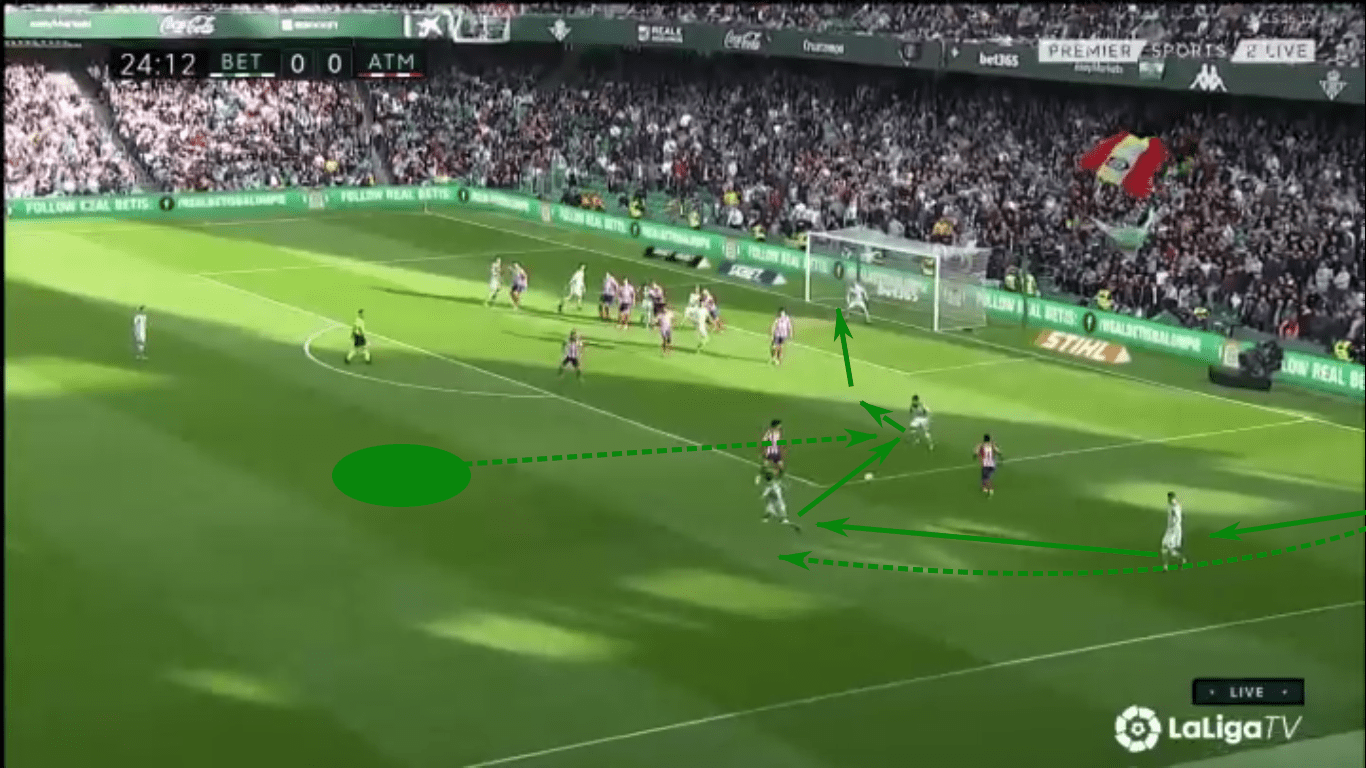
Here we see Atlético send two to defend a short corner. However, Fekir joined the play and ran behind the two Atlético defenders. Guardado split the defence with his pass and Fekir’s shot nearly gave Betis the lead.
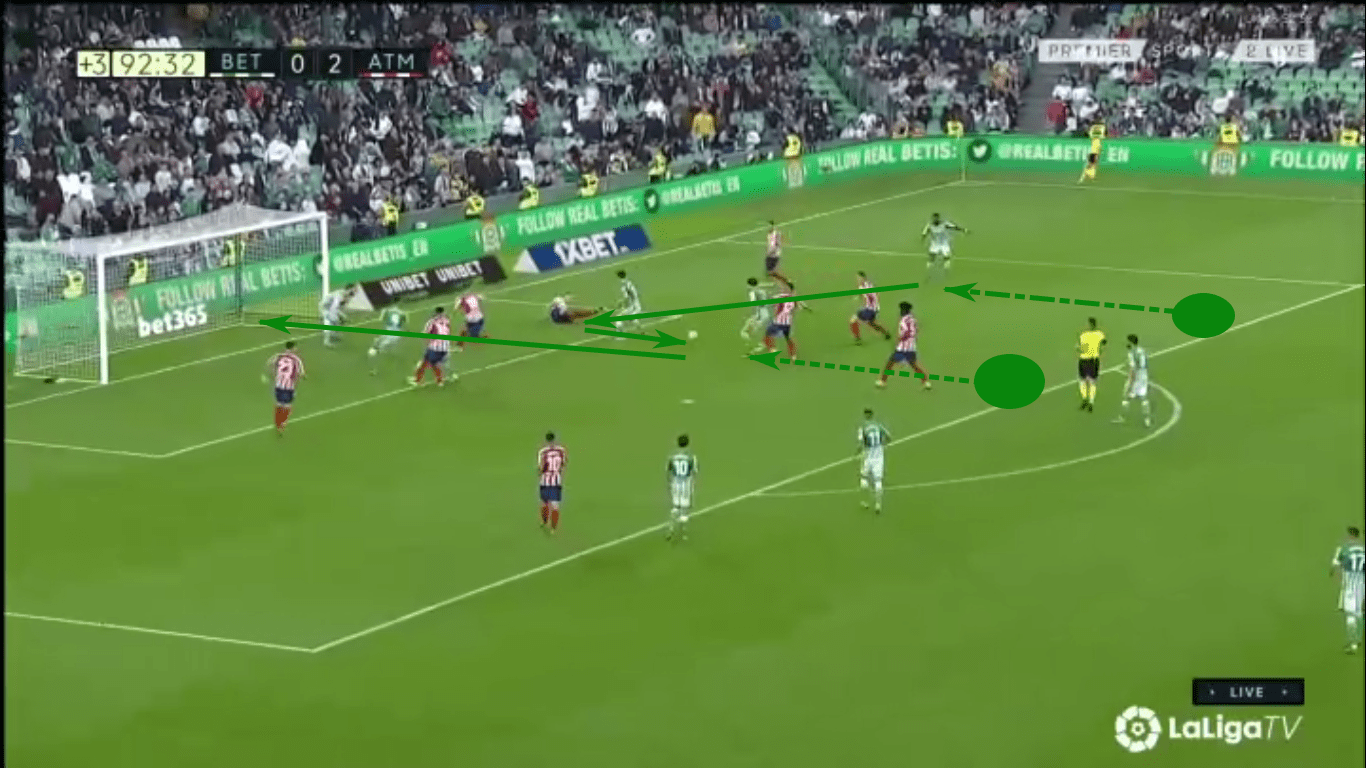
The consolation goal for Betis came after Atlético cleared the initial corner. With the ball out of bounds for a throw-in, Betis took the throw quickly, effectively giving them the same set up as a short corner. Both teams still had their best aerial players in the box, so Betis overloaded the left-wing to pull some of the Atlético defenders out of the box.
As soon as the fourth defender arrived, Betis switched play. Thomas and Marcos Llorente over pursued on the tackle. Fekir split them with a pass to Bartra, who played Emerson, allowing the outside-back to drive the ball to the near post. The last line of defenders has great coverage and positioning, but the second line was behind the play. As the cross was poked away, it landed at the feet of Bartra, who powered the shot off Felipe’s chest and into the goal.
Atlético attack vs Betis’ counterpressing
Real Betis was phenomenal counterpressing Atlético. The moment Atlético won the ball, the nearest Betis defender swarmed to the first attacker while the remaining defensive players made space near the ball compact and took away passing lanes. Atlético had very little time on the ball, as evidenced by Betis’ 6.4 PPDA (passes per defensive action in the opponent’s final 60% of the field) compared to Atlético’s 16.4. Even in the build-up, Atlético had very little time to play. With Morón, Joaquín and Fekir playing in the central channel and half-spaces, as well as Emerson and Moreno playing high up the pitch, Betis was able to apply immediate pressure on Atlético.
Knowing Betis would press high up the field, Atlético came out looking for the long ball and counterattacks. It’s better to play long than concede an opportunity close to goal. On the day, the Madrid side played only 251 passes, 48 of them were long balls. Doing some quick math, 19% of Atlético passes went long as compared to 5% for Betis. Oblak’s distributions tended to go long too, targeting Morata, Saúl and Lemar. 14 of his 16 distributions were successful in reaching the target.
Atlético still finished with a better xG (1.61 to 1.13) and really should have scored a couple more. Morata finished a João Félix cross in the 8th minute but was a shoulder’s width offside. Then in the 35th minute, Morata headed a clearance to Joao Felix, who played the Spaniard in behind the defence from just inside the Atlético half. Morata raced onto the ball and dribbled 40-metres unopposed, but saw his shot saved by Robles. The shot caromed off the post and back into the keeper’s hands.
Though Athletico had some success playing long, the inability to play out of the Real Betis press led to few and short possessions. Even with numbers up, Athletico still struggled to build out against this pesky Betis side.
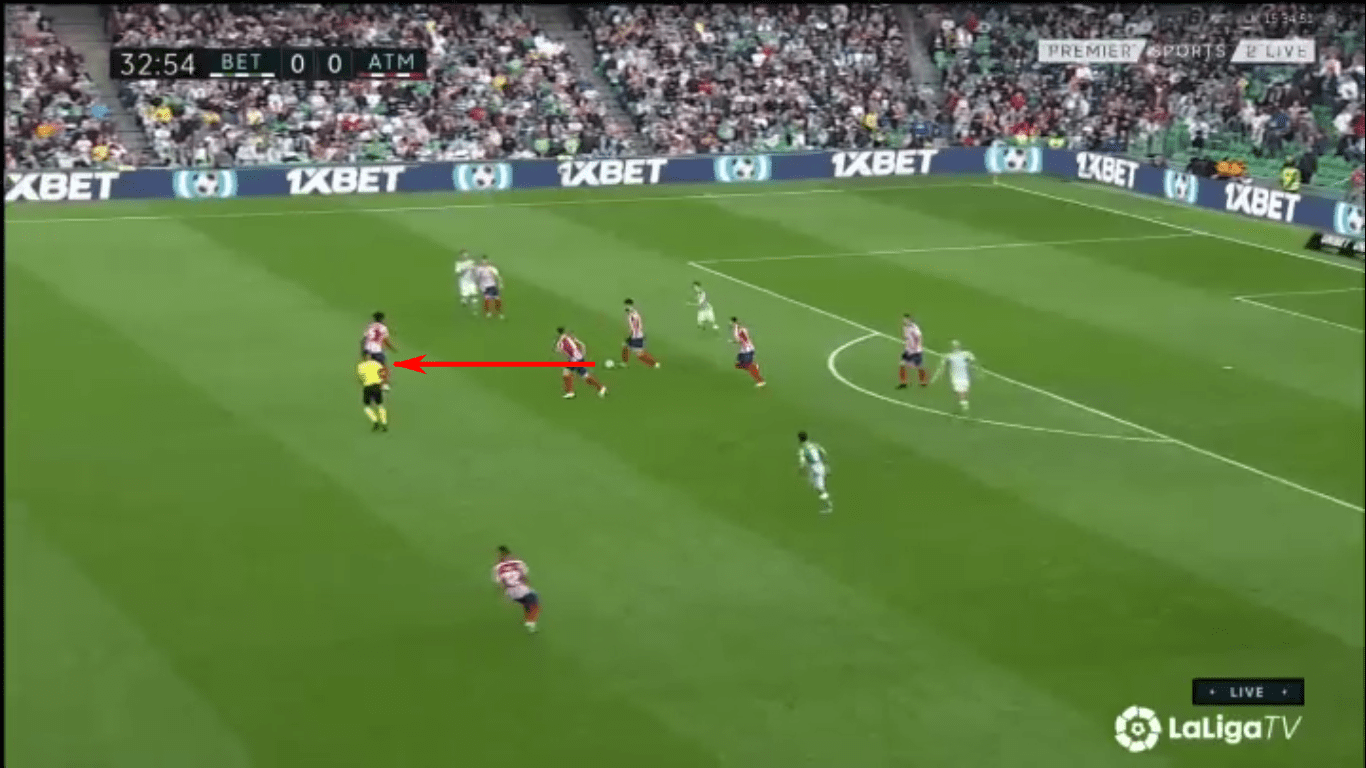
In this instance, Felipe won the ball and passed to Thomas. Counting Oblak, Atlético has 9v4 in this image. Safe numbers to build out, right?
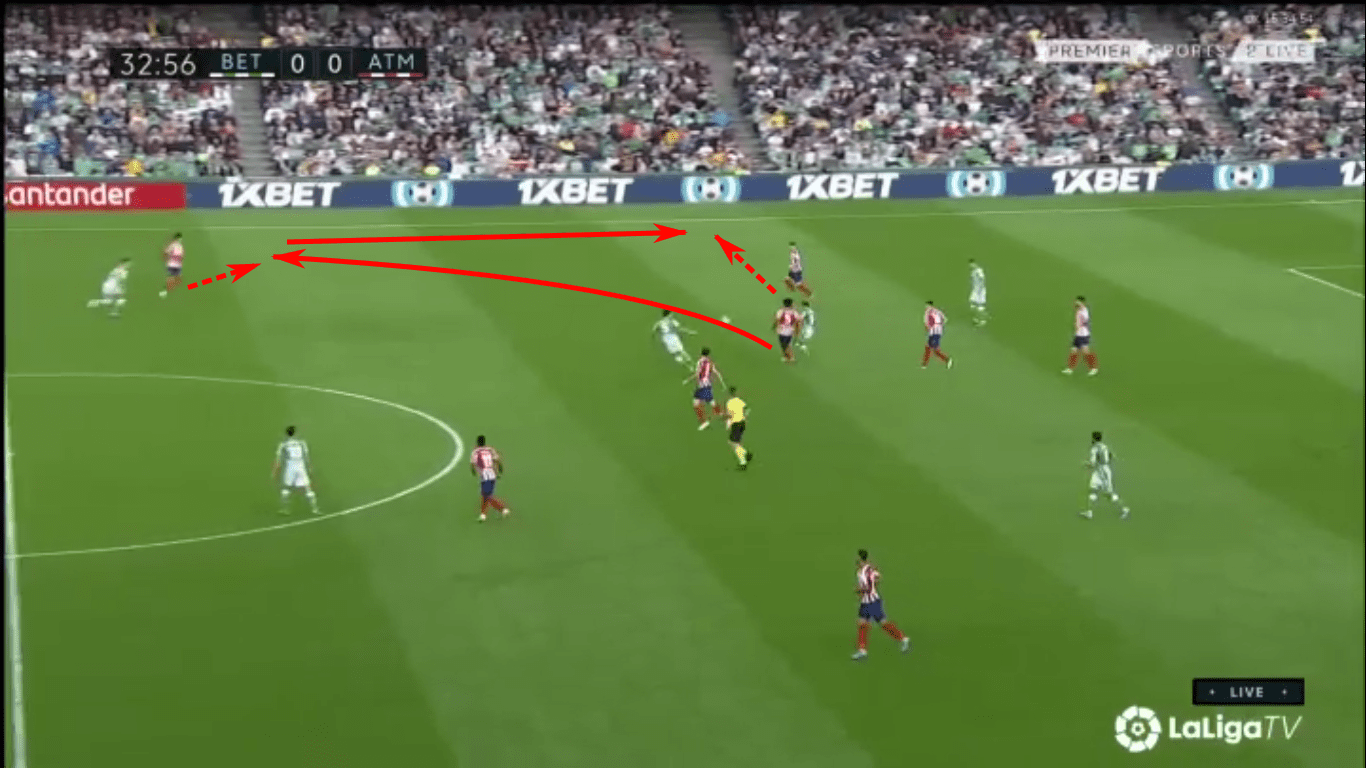
Not with this Betis counterpressing. Thomas played behind João Félix, whose touch restricted his options, so he played negative to Trippier.
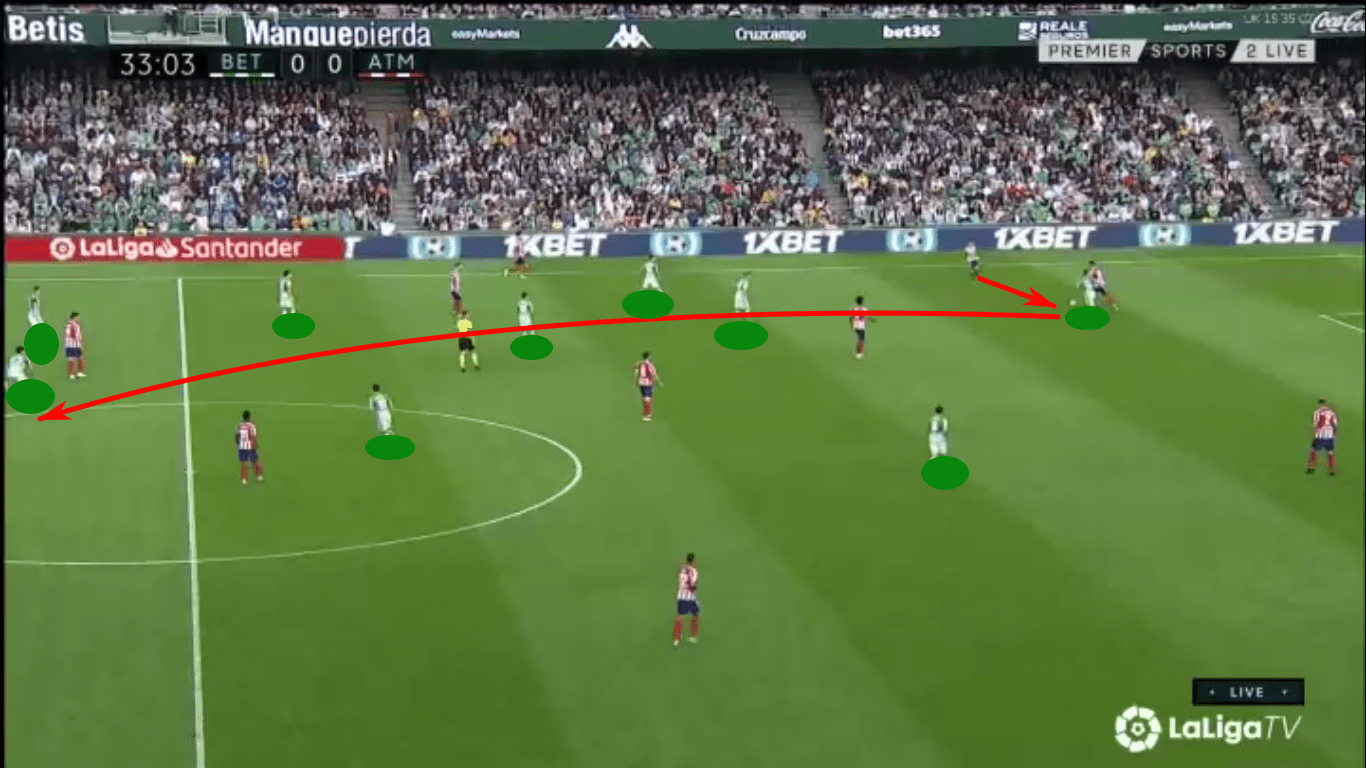
Trippier then played back to Felipe, who was already under pressure. The centre-back’s first touch only added to his lack of time and space. Rather than risking a turnover in his own end, he played forward. Mandi, whose body orientation is perfectly situated in a back to the touchline position, is first to the ball, restarting the Betis attack.
Conclusion
Real Betis simply couldn’t crack the Atlético Madrid defence. Knowing that Atlético would congest the middle and half-spaces, Betis attacked via the wings, but the long diagonal passes always gave Atlético enough time to move the whole team into position. Quicker combinations to the middle with negative pass would have pulled the midfield to the centre, releasing space on the wings. Further, with the touchline restricting its attack, Betis then had to endure intense pressure from Atlético on the wings. The lack of incisive passing in the final third is something they’ll look to correct during the Christmas break.
Atlético Madrid wasn’t great in the attack, but they were just good enough to capitalize on a couple of mistakes and claim the three points. Just good enough is the story of their season as they’re wildly underperforming in xG, but still remain within a shout of the top. They’ll happily take this result, but difficult fixtures in January and February will require greater attacking efficiency.

If you love tactical analysis, then you’ll love the digital magazines from totalfootballanalysis.com – a guaranteed 100+ pages of pure tactical analysis covering topics from the Premier League, Serie A, La Liga, Bundesliga and many, many more. Buy your copy of the December issue for just ₤4.99 here





Comments